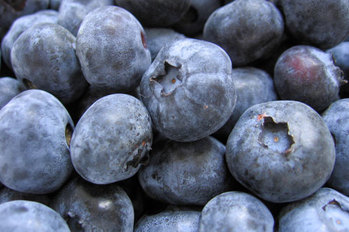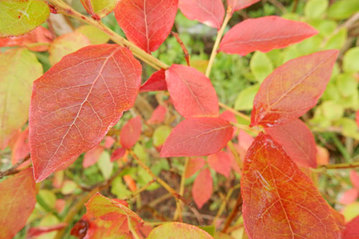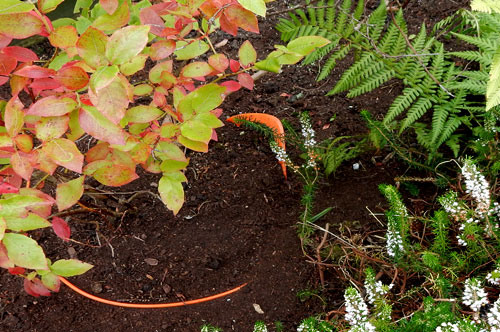Warriston variety of the month
A monthly selection of fruit, veg or flowers that flourish on the Warriston site.
|
Blueberry
photo credit: Jeff Kubina Bright Warriston blueberry foliage in autumn
photo credit: NM Blueberry in a large plastic trug (with drainage holes) sunk into ground and filled with ericaceous compost
photo credit: NM |
October 2021 Blueberry 'Chandler'Two Warriston plot holders give us the low down on blueberries.
Alison, plot 1 on the west side says: “I'm just coming to the end of an excellent blueberry crop. One of the good things about them is they don't all ripen at once, causing a glut. I also extend my season by growing several varieties; you get better pollination with more than one, though if your neighbours have got one that'll do it—they don't have to be close. You've probably heard they like acid soil, but more than that, they hate alkali. Best bet is to dig a pit and fill it with ericaceous (acid) compost to plant them in, failing that a large container. I say large because the other thing they hate is drying out. They prefer rainwater to tap. Oh, and don't forget to net them or the birds will scran all the berries.” AB Another west side plot holder says: “We've all heard that blueberries are a so-called 'super food', and supermarket prices often reflect this, with a small punnet costing upward of £3. However, just like many other soft fruits and berries, blueberries thrive in our cool, wet Scottish climate—so if you can find a suitable permanent spot on your allotment, they're well worth growing. ‘Chandler’ is a mid/late season variety that produces very large berries with a slightly flattened shape—sometimes as big a 10p piece! Here's some blueberry facts below. Description: A perennial fruit bush with attractive bell shaped flowers and fruit that ripens between June and September (depending on variety), blueberry bushes are hardy and should have no problem coping with the average Scottish winter. Once established, (sometimes a few years), plants should provide good harvests for many years to come. Planting: Blueberry bushes are usually bought as young plants in late winter. As they're ‘acid loving’ plants, they'll need to be grown in ericaceous compost—for this reason they're often grown on in pots or raised beds where soil acidity can be controlled. They also prefer to be watered with rainwater, rather than tap. Other than that, place them in a sunny spot and they should do well. Many blueberry varieties are self fertile, but for maximum crops it's always recommended to grow at least two in close proximity. Fully grown bushes can reach 1.5 metres high and wide, so space accordingly. Pests: Blueberries don't suffer from the usual array of allotment pests, although blackbirds might take a fancy to your crop, so net if you're not willing to share. Eating: Eaten fresh or added to cakes, muffins etc, blueberries are delicious and nutritious, and have been found to have various health benefits including maintaining healthy bones, lowering blood pressure, and managing diabetes. History: Wild blueberries originally hail from North America, where the Native Indians used them as a flavouring and for medicinal purposes. However, what we know as blueberries today have only been around for a hundred years, as they were cultivated between 1908-1916 in the U.S. for commercial purposes.” NS Blueberry varieties including 'Chandler' can be bought from Scotplants Direct in Fife at www.scotplantsdirect.co.uk |





